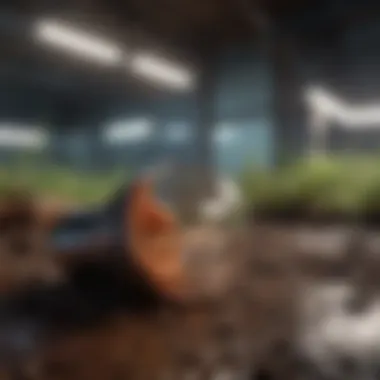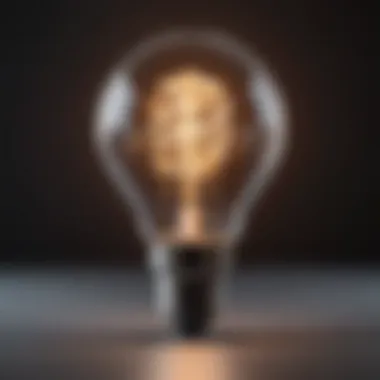A Complete Guide on Fluorescent Bulb Disposal and Recycling


Overview of the Topic
Fluorescent bulbs, a common lighting solution, raise concerns about proper disposal and environmental impact. The components of these bulbs, such as mercury, present challenges in safe disposal and recycling. Understanding the importance of eco-friendly practices is essential in minimizing the negative consequences these bulbs pose to the environment.
Current Challenges
The current landscape of fluorescent bulb disposal involves issues like improper handling leading to mercury leakage and soil contamination. Lack of awareness among users contributes to the improper disposal of these bulbs, further exacerbating environmental risks. Addressing these challenges requires a cohesive approach towards responsible disposal methods and raising awareness about the impact of incorrect bulb disposal practices.
Sustainable Solutions
To combat the environmental threats posed by fluorescent bulbs, sustainable practices must be implemented. Encouraging the use of recycling programs and designated disposal facilities can significantly reduce the ecological footprint of these lighting solutions. Case studies showcasing successful recycling initiatives and effective waste management strategies provide a roadmap for sustainable bulb disposal practices.
Impact and Significance
The impact of improper fluorescent bulb disposal extends beyond environmental degradation to affecting communities and future generations. Ecosystems suffer from mercury contamination, posing health risks to wildlife and humans alike. The importance of conservation efforts and sustainable resource use cannot be overstated in safeguarding our environment and preserving resource integrity for generations to come.
Introduction
In today's rapidly advancing world, where environmental concerns are taking center stage, the proper disposal and recycling of fluorescent bulbs have become crucial topics of discussion. With the widespread use of fluorescent lighting in residential, commercial, and industrial settings, understanding how to manage these bulbs responsibly is paramount. This comprehensive guide delves deep into the intricacies of fluorescent bulb disposal and recycling, shedding light on key aspects that warrant attention and action.
As we unravel the layers of this guide, we will navigate through the composition of fluorescent bulbs, examining their intricate components and the implications of improper disposal methods. By shining a light on the benefits and drawbacks of fluorescent bulbs, readers will gain a nuanced perspective on why these lighting solutions are both praised and scrutinized in today's environmental landscape. Furthermore, we will explore the environmental impact of improper disposal, emphasizing the need for sustainable practices in handling end-of-life fluorescent bulbs.
The importance of safe handling and storage practices cannot be overstated when it comes to fluorescent bulbs. Proper precautions for managing broken bulbs and implementing effective storage solutions are essential in minimizing the risks associated with these potentially hazardous items. By understanding the best practices for handling and storing fluorescent bulbs, individuals can play a pivotal role in creating a safer environment for themselves and future generations.
In the subsequent sections of this guide, we will delve into the various disposal options available to individuals looking to make a positive impact on the environment. From local recycling programs to retailer take-back initiatives, readers will discover the array of choices at their disposal for ethically managing their fluorescent bulbs. By shedding light on the processes involved in recycling fluorescent bulbs, including collection, transportation, processing, and reclamation, this guide aims to demystify the path to eco-friendly disposal.


Moreover, we will explore DIY recycling methods that empower readers to take a hands-on approach to managing their fluorescent bulbs. From separating components for recycling to exploring creative reuse and repurpose ideas, individuals will find practical tips for giving their old bulbs a new lease on life. By advocating for proper disposal practices, this guide seeks to underscore the environmental benefits that come with making conscientious choices in handling fluorescent bulbs, thereby preserving our planet for future generations.
Understanding Fluorescent Bulbs
Fluorescent bulbs play a crucial role in modern lighting solutions due to their energy efficiency and longevity. Understanding the composition and functioning of these bulbs is essential for informed decision-making regarding their use and disposal. These bulbs contain mercury vapor and a mixture of noble gases encased in a phosphor-coated tube. When electricity passes through the tube, the mercury emits ultraviolet light, stimulating the phosphor to produce visible light. While fluorescent bulbs are energy-efficient and durable, they also have drawbacks such as mercury content, which poses environmental and health risks if not handled properly.
Composition of Fluorescent Bulbs
The composition of fluorescent bulbs includes a glass tube filled with a small amount of mercury, noble gases like argon and krypton, and a phosphor powder coating. The mercury vapor emits UV light when ionized by an electrical current, which then causes the phosphor coating to fluoresce, producing visible light. Understanding this composition is crucial as it highlights the hazardous materials present in these bulbs, emphasizing the importance of safe disposal methods to prevent environmental contamination and health risks.
Benefits and Drawbacks of Fluorescent Bulbs
The benefits of using fluorescent bulbs lie in their energy efficiency, longer lifespan compared to incandescent bulbs, and brighter illumination. However, their drawbacks center around the presence of mercury, a toxic substance that requires careful handling and proper disposal to avoid polluting the environment. While fluorescent bulbs help save energy and reduce electricity bills, their environmental impact should not be overlooked, making it crucial to explore eco-friendly disposal options to mitigate harm.
Environmental Impact of Improper Disposal
Improper disposal of fluorescent bulbs poses a significant environmental hazard due to the release of mercury into the air, soil, and water sources. When these bulbs end up in landfills or incinerators, the mercury can contaminate the environment, leading to health risks for humans and wildlife. Understanding the environmental impact of improper disposal underscores the urgency of adopting safe recycling practices to minimize pollution and promote sustainability for a healthier planet.
Safe Handling and Storage
In the realm of fluorescent bulb management, safe handling and storage stand out as pivotal facets demanding meticulous attention. This section of the article delves into the essentiality of ensuring secure procedures when dealing with these bulbs, shedding light on the potential risks and best practices to mitigate them effectively. By understanding the significance of safe handling and storage, individuals can safeguard themselves and the environment from harmful consequences. One cannot underestimate the gravity of this topic in the broader context of fluorescent bulb disposal, considering the delicate nature of these bulbs and the hazardous materials they contain. Proper handling not only reduces the chances of breakage but also minimizes exposure to toxic substances, safeguarding both human health and the environment with equal emphasis. Storage practices also play a critical role in maintaining the integrity of fluorescent bulbs, prolonging their lifespan, and facilitating safe transportation for eventual recycling or disposal.
Precautions for Handling Broken Bulbs
When it comes to broken fluorescent bulbs, a heightened level of caution must be exercised to avert potential dangers associated with the release of mercury vapors. Individuals handling shattered bulbs should prioritize safety measures such as wearing protective gloves, using a sealable container for debris collection, and ventilating the area to disperse any vapors. Prompt cleanup is imperative to prevent mercury exposure through inhalation or skin contact. Additionally, it's paramount to avoid using a vacuum cleaner as it can spread mercury particles further. Proper disposal of broken bulbs is also crucial, following designated protocols to prevent environmental contamination and health risks.
Proper Storage Practices


Efficient storage practices are instrumental in preserving the quality and functionality of fluorescent bulbs while ensuring safety during handling and transportation. Storing bulbs in a secure, dry location away from high-traffic areas reduces the risk of accidental breakage and exposure to damaging elements. Utilizing original packaging or durable containers designed for bulb storage can prevent physical damage and maintain bulb integrity. Proper labeling of stored bulbs with relevant details such as installation date and type enhances organization and facilitates tracking for efficient replacement or disposal. Adhering to recommended storage conditions is fundamental in prolonging the lifespan of fluorescent bulbs and optimizing their recyclability, underscoring the importance of thoughtful storage practices in responsible bulb management.
Disposal Options
In the realm of fluorescent bulbs, embracing efficient and eco-friendly disposal methods is imperative. The significance of exploring various disposal avenues cannot be overstated as ineffective disposal can lead to detrimental environmental consequences. When deliberating on disposal options, key elements such as sustainability, safety, and environmental impact should remain at the forefront of decision-making. By unraveling the intricacies of disposal methods featured in this article, individuals can cultivate a profound understanding of how their choices can influence the ecosystem positively or negatively.
Local Recycling Programs
Local recycling programs serve as dynamic platforms fostering a culture of sustainability within communities. These initiatives are tailored to streamline the process of recycling fluorescent bulbs by providing designated drop-off points or curbside collection services. Participation in local recycling programs cultivates a sense of environmental responsibility while contributing to the circular economy. By actively engaging with these programs, individuals can witness firsthand the transformation of used fluorescent bulbs into valuable secondary resources, thus reducing the strain on virgin materials and diminishing waste accumulation.
Retailer Take-Back Programs
Retailer take-back programs exemplify corporate social responsibility in action by offering customers a convenient avenue for recycling fluorescent bulbs. Retailers, cognizant of their role in waste management, facilitate the return of used bulbs to ensure proper disposal and promote sustainable practices. The seamless integration of take-back programs into retail operations underscores the commitment of businesses towards environmental stewardship. Leveraging these programs not only enhances the accessibility of recycling options for consumers but also strengthens the ethos of sustainability within commercial frameworks.
Household Hazardous Waste Facilities
Managing hazardous waste, including fluorescent bulbs, necessitates specialized treatment and disposal mechanisms to prevent environmental contamination. Household hazardous waste facilities play a pivotal role in accommodating the safe disposal of fluorescent bulbs, shielding both public health and the environment from potential harm. These facilities adhere to stringent waste management protocols, ensuring the secure handling and processing of hazardous materials. By utilizing household hazardous waste facilities, individuals can mitigate the risk of toxic pollutants entering ecosystems, fostering a cleaner and healthier living environment for present and future generations.
Recycling Process
In the realm of fluorescent bulb disposal, the Recycling Process stands as a pivotal aspect, offering a sustainable solution to mitigate environmental repercussions. Championing the conservation ethos, this section delves into the intricate system of recycling fluorescent bulbs, emphasizing the significance of responsible waste management. The crux of Recycling Process lies in its ability to divert hazardous materials from landfills, curbing soil and water contamination. By dissecting the journey of used fluorescent bulbs from collection to reclamation, readers gain a nuanced understanding of the meticulous processes involved in recycling, underscoring the need for conscientious disposal practices.
Collection and Transportation
Initiating the Recycling Process, Collection and Transportation mechanisms play a crucial role in ensuring the seamless transfer of discarded fluorescent bulbs to recycling facilities. The logistical orchestration of this phase involves the deployment of specialized collection centers and vehicles equipped to handle mercury-containing bulbs safely. Through meticulous planning and implementation, hazardous waste collection teams navigate urban landscapes, bridging the gap between consumers and recyclers. Emphasizing safety protocols and efficient logistics, this stage fortifies the foundation of the Recycling Process, streamlining the convergence of used fluorescent bulbs for sustainable treatment.
Processing and Reclamation


Within the enclaves of recycling facilities, the Processing and Reclamation stage unfolds, marking the transformative journey of discarded fluorescent bulbs into raw materials for new productions. Here, state-of-the-art technologies harmonize with eco-friendly practices to segregate glass, metals, and phosphor powders, facilitating their reincorporation into manufacturing processes. The adept hands of recycling experts ensconce element extraction methodologies, purifying mercury for reuse and repurposing glass components. Through the alchemy of innovative processing techniques, the Recycling Process transcends mere waste management, embodying a beacon of sustainability and resource efficiency.
DIY Recycling Methods
Importance of DIY Recycling Methods in this Article
In the realm of fluorescent bulbs, DIY recycling methods emerge as a crucial element contributing significantly to the overarching goal of sustainable waste management. By delving into the specifics of DIY recycling within this comprehensive guide, readers are enlightened on the pragmatic and eco-conscious approach to dealing with spent fluorescent bulbs. This particular segment sheds light on the practicality and environmental impact of taking recycling into their own hands, fostering a sense of responsibility and empowerment among individuals seeking to minimize their carbon footprint.
Separating Components for Recycling
When considering the process of recycling fluorescent bulbs, a pivotal step lies in the meticulous separation of their components. This intricate task involves disassembling the bulb to segregate glass, metals, phosphor powder, and other materials for subsequent recycling procedures. By elucidating the importance of methodical component separation, this section underscores the essence of maximizing recycling efficiency while minimizing waste and environmental pollution associated with improper disposal practices.
Reuse and Repurpose Ideas
Beyond conventional recycling approaches, exploring innovative reuse and repurpose ideas for fluorescent bulbs unlocks a realm of creative and sustainable possibilities. From transforming old bulbs into decorative pieces or crafting DIY planters, the scope for repurposing these items is vast and inspiring. This section sparks creativity while advocating for a circular economy mindset, where waste is transformed into valuable resources through imaginative and environmentally considerate practices.
Environmental Benefits of Proper Disposal
In the realm of environmental conservation, the crucial aspect of properly disposing of fluorescent bulbs cannot be understated. The environmental benefits derived from the correct management of these bulbs are multifaceted and impactful. First and foremost, by ensuring that fluorescent bulbs are disposed of in an eco-friendly manner, the release of harmful substances such as mercury and other toxic components into the environment is minimized significantly. This reduction in toxic contamination plays a vital role in safeguarding ecosystems and protecting both human and wildlife health.
Moreover, the proper disposal of fluorescent bulbs leads to enhanced resource efficiency. Through recycling and reclamation processes, valuable materials like glass, aluminum, and phosphor can be extracted and repurposed, reducing the demand for raw materials and cutting down on energy consumption associated with fresh production. By participating in the proper disposal of fluorescent bulbs, individuals contribute to the circular economy, where resources are kept in use for as long as possible, promoting sustainability and resource conservation.
Additionally, conscientious bulb disposal practices contribute to a reduction in greenhouse gas emissions. When fluorescent bulbs are incinerated or end up in landfills, they pose a risk of releasing mercury vapor and other greenhouse gases into the atmosphere, contributing to air pollution and climate change. By opting for recycling options provided by local programs or retailers, individuals can help mitigate these adverse environmental impacts and make a positive contribution to climate action.
Furthermore, promoting awareness about the importance of proper bulb disposal fosters a culture of environmental stewardship and responsibility. Encouraging communities to engage in sustainable waste management practices not only benefits the immediate environment but also sets a precedent for future generations. Educating the public about the environmental benefits of proper bulb disposal instills a sense of accountability and encourages proactive behavior towards preserving the planet for years to come.
Conclusion
The Conclusion section of this comprehensive guide on dealing with fluorescent bulbs encapsulates the essence of vital considerations and outcomes discussed throughout the article. Fluorescent bulbs, despite their energy efficiency and longevity, pose significant environmental challenges if not properly handled and disposed of. The importance of conscientious disposal methods cannot be overstated in the broader context of sustainable waste management. Life cycle analysis demonstrates that the eco-friendly approach to managing used bulbs significantly reduces the carbon footprint and prevents toxic substances from leaching into the environment.
Therefore, adopting responsible practices such as recycling at designated collection points or through retailer take-back programs is imperative. Not only does this contribute to resource conservation by reclaiming valuable raw materials, but it also aids in reducing the demand for new production, subsequently decreasing energy consumption and greenhouse gas emissions. Moreover, proper disposal methods prevent the release of mercury and other hazardous chemicals into the atmosphere, safeguarding both human health and ecosystem integrity.
In essence, this conclusive segment underlines the overarching theme of environmental stewardship and individual responsibility in mitigating the adverse effects of fluorescent bulb disposal. By adhering to the guidance presented in this guide, readers can actively engage in sustainable practices, thereby fostering a greener and healthier future for generations to come.



